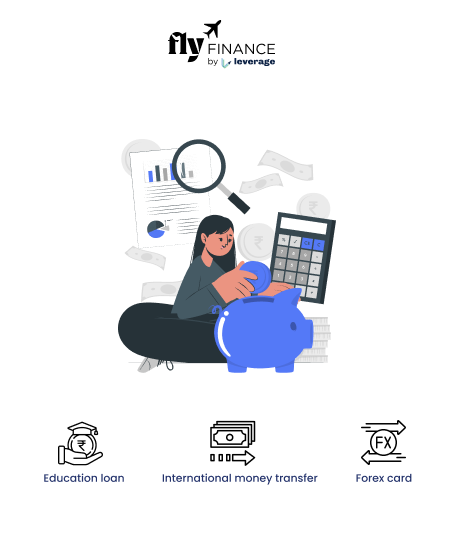RLLR relates to the repo rates set by the Reserve Bank of India based on which financial institutions further lend loans to the borrowers. It directly impacts the interest rates on the education loans or any other loan availed from the banks. Let’s get into the details of RLLR rates, how they work, their role in education loan interest rate calculation, and other important information.
Table of contents
What is the Full Form of RLLR?
The full form of RLLR is Repo Linked Lending Rate. RBI sets the repo rates, which act as a benchmark rate and serve as the foundation for determining loan interest rates banks offer. Financial institutions further lend loans to borrowers based on the RLLR. The present repo rate is 6.50% ( as of 25 April 2024).
- The RLLR depends on various factors like inflation, borrowings, economic trends, and growth projections.
- Due to this, RBI frequently reviews and changes the current repo rate every quarter i.e. in three months.
- Education loans based on RLLR have floating interest rates that are subject to revisions based on these factors.
- Based on the changes in the repo rate, banks adjust their RLLR, which further influences the interest rates on various loans, including education loans.
Also Read: Having a gap after higher studies for entrance preparations or career building? Check out the details about obtaining a gap certificate for an education loan.
RLLR in Education Loans
Study abroad aspirants or those who plan to secure funds for higher studies must know about the importance of RLLR in calculating education loan interest rates. The interest rates linked to RLLR significantly impact the overall cost of education loans and the repayment burden, as these interest rates move up and down based on the changes in repo rates set by the RBI.
RLLR-based education loans have transparent interest rates which are the benchmark rates set by the RBI. These are directly available to the public offering them transparency. However, frequent fluctuations (particularly rise in repo rates) can also affect the borrowers. Situations like inflation can impact repo rates and in turn, education loans. The impact and effect of inflation on education loans are bad, but these strategies to deal with education loans during high inflation can help you deal with the situation wisely.
You can refer to the table given below to find out more about the education loan interest rates charged by different lenders and their calculations in detail-
Calculation of RLLR
The RLLR rate is calculated as the sum of the repo rate and spread. The repo rate is the rate at which RBI lends loans to the commercial banks and spread is the percentage calculated by individual banks to cover their operational costs and profit margin. Thus, different banks have different loan interest rates due to different values of spread.
RLLR = Repo Rate + Spread
- Changes in the repo rate determined by the RBI lead to changes in the calculation of the RLLR rate. These changes, in turn, affect the interest rate calculation of loans, including education loans.
RLLR Rates of Different Banks in India
Different banks have different RLLR rates and they keep on changing from time to time. Here’s the list of popular lenders and the recent RLLR rates offered by them on loans, including education loans.
| RLLR of Different Lenders | RLLR Rate |
| RLLR of SBI | 8.75% |
| RLLR of PNB | 9.25% (RLLR- 9.00% + BSP- 0.25%) |
| RLLR of Canara Bank | 9.25% |
| RLLR of Bank of Maharashtra | 9.30% |
| RLLR of Indian Overseas Bank | 9.35% |
| RLLR of HDFC Bank | 6.50% |
| RLLR of IDBI Bank | 9.10% |
| RLLR of Central Bank of India | 9.35% |
Please Note: These Repo Rates are mentioned as per the official bank website and are applicable as of 25 April 2024. Changes in policies, economic trends, and RBI revisions lead to frequent changes in the RLLR rates.
There are some related terms to RLLR rates that you might come across when taking a loan from the bank. These include words like MCLR, base rate, spread, and reset period. Let us help you with the easy-to-understand definitions of these terms for easy understanding of the concept related to RLLR.
MCLR
MCLR refers to the Marginal Cost of a Fund-Based Lending Rate. This rate is set by the banks in alignment with RBI guidelines. It is a benchmark rate below which the banks cannot lend loans to borrowers. It is a reference rate for the banks to decide the interest rates they can charge on loans.
Base Rate
Base rate refers to the minimum benchmark rate set by the RBI below which the Indian banks are not permitted to lend to their customers. It is based on the same principle as MCLR, but both of them have a difference. The base rate is determined by the average cost of funds and MCLR is determined by the marginal cost of funds.
Spread
Spread is the percentage calculated by individual banks to cover their operational costs and profit margin. It is also calculated as the difference between the interest rate charged by banks on loans to private sector customers minus the interest rate paid by commercial or similar banks for demand, time, or savings deposits.
Reset Period
The reset period refers to the time duration after which the interest rates are reset or readjusted.
Also Read: Comparing education loan interest rates is one of the best practices before applying for a loan with any lender. Compare the education loan interest rates of leading banks and NBFCs to find the best-suited lender.
RLLR vs MCLR: The Difference
RLLR and MCLR are both used to calculate the interest rates charged by the banks on the loans. Some banks use the RLLR rates while others use MCLR rates based on their terms and conditions and policies. However, there are differences. Let’s have a look at how RLLR rates are different from MCLR rates.
| RLLR | MCLR |
| The full form of RLLR is a Repo-linked Loan or Lending Rate. | The full form of MCLR is the Marginal Cost of a Fund-Based Lending Rate. |
| RLLR-linked interest rates on loans are calculated based on the Repo rate set by the RBI. | MCLR-linked interest rates on loans are determined by the marginal cost of funds, below which banks are not permitted to lend loans to customers. |
| RBI sets the RLLR rates. | The banks set the MCLR rates adhering to the guidelines set by the RBI. |
| The reset period of RLLR is 3 months. | The reset period of MCLR differs from bank to bank and is usually between 6-12 months. |
| RLLR = Repo Rate + Spread | MCLR = Marginal Cost of Funds + Operation Costs + Tenor Premium |
FAQs
RLLR is the Repo Linked Loan or Lending Rate. It is a rate set by RBI at which is lends loans to commercial banks. Based on the same, the financial institutions further calculate their interest rates and lend loans to the borrowers.
RLLR is reviewed by the RBI every three months as it is based on factors like inflation, borrowings, and economic trends in the country. Based on the changes in the repo rate, banks adjust their RLLR, which further influences the interest rates on various loans, including education loans.
Education loan interest rates linked to RLLR are determined based on the repo rate set by the RBI and the spread charged by the banks. The interest rates linked to RLLR have floating interest rates as these interest rates fluctuate based on the changes in repo rates set by the RBI.
RLLR rates are the repo-linked lending rates. Such interest rates on loans are determined by the repo rate set by the banks and are calculated as the sum of the repo rate and spread. MCLR refers to the Marginal Cost of a Fund Based Lending Rates which are the benchmark rates below which banks are not allowed to lend. are set by the banks and are determined by the marginal cost of funds, operating costs, and tenor premium.
RBI frequently reviews and changes the current repo rate every quarter i.e. in three months due to changes in economic trends, inflation, growth prospects, and others. Thus, RLLR-linked interest rates have floating interest rates.
This was all about the full form of RLLR, its working, how it affects the education loan interest rates, their calculation, related terms, and the major differences between RLLR and MCLR-based interest rates.
To know more about education loans, the best bank accounts for students, forex and banking experience for global students or international money transfers, reach out to our experts at 1800572126 to help ease your study abroad experience.
Follow Us on Social Media





























